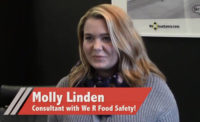[Video] How to combat heat resistant bacteria
Editor-in-chief Andy Hanacek spoke with We R Food Safety! consultant Molly Linden about heat resistant bacteria and how producers can work to reduce instances of heat resistant bacteria while putting in procedures to deal with it if it occurs.
Andy Hanacek: As an industry, what can we do to change the approach? We kind of got into it a little bit here, but give me a little bit more on what the industry can do. If Appendix A isn’t addressing that, what should the industry be doing? What’s the next steps?
Molly Linden: First of all, it’s very important for producers to know exactly what causes heat resistance, how they can avoid it themselves, and starting at the beginning of the process and working their way up to cooking in order to ensure that bacterial loads are as small as they can be. This starts when the product is raw with safe handling procedures, sanitation, both of the raw products and the food contact surfaces and being able to go through each one of your steps and make sure that bacterial loads are much less than you want them to be, so that when you get to cooking, there’s less of a chance that you’re going to be getting those heat resistant bacteria. In addition to that, it’s also really important that producers have in place procedures in case their cooking process fails, in case power goes out and your cookhouse is set at 80 degrees and it stays there for an extended amount of time and you end up getting heat resistant bacteria or spores or any number of those things. Having procedures set in place in very important to ensure that you can keep those contaminants contained in the facility without contaminating anything else. Lastly, I just have to say that the USDA really needs to put more attention to towards heat resistant bacteria to make sure that we can modify Appendix A and make sure we have enough studies in place to support it, so that we can really show producers how correctly to cook their products so that there is no confusion and really to just pay attention to a topic within the micro community and the food industry to say this is something that needs to be addressed. It’s something that can cause illness in consumers and really just a public safety hazard.
See more videos with We R Food Safety!
This article was originally posted on www.provisioneronline.com.
Looking for a reprint of this article?
From high-res PDFs to custom plaques, order your copy today!





